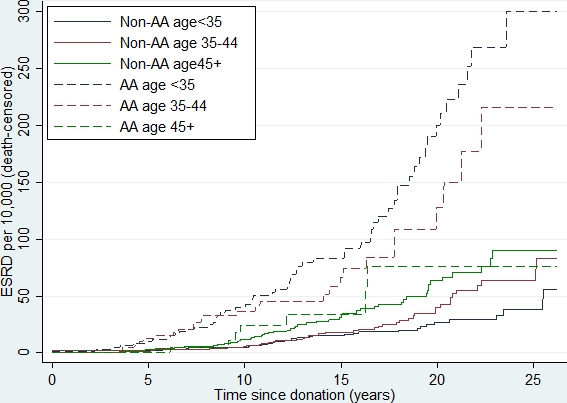Quantifying Risk of ESRD in Live Kidney Donors
A. Massie, A. Muzaale, X. Luo, D. Segev.
Johns Hopkins, Baltimore.
Meeting: 2015 American Transplant Congress
Abstract number: B166
Session Information
Session Name: Poster Session B: Living Donor Issues 1
Session Type: Poster Session
Date: Sunday, May 3, 2015
Session Time: 5:30pm-6:30pm
 Presentation Time: 5:30pm-6:30pm
Presentation Time: 5:30pm-6:30pm
Location: Exhibit Hall E
Among live kidney donors higher overall risk of ESRD has been shown in African-Americans and men. However, individual risk of ESRD has not been quantified.
METHODS: We studied risk factors for ESRD (demographics, relatedness to recipient, ZIP code median annual HH income (MAHI), BMI, SBP) in 122,697 live donors using SRTR data and Cox regression. ESRD outcomes 1994-2013 were obtained via CMS linkage; Late entries were used for donors prior to 1994.
RESULTS: Male gender (HR=1.59 2.05 2.64, p<0.001) and African-American (AA) race (HR=2.41 3.29 4.50, p<0.001) were associated with higher risk of ESRD (Table, col 1). Among non-AA donors, older donors had higher incidence of ESRD; however, among AA donors, older donors had lower incidence of ESRD (Figure 1). The race/age interaction was statistically significant (Table, col 1). MAHI<$40K was associated with higher risk (HR=1.04 1.48 2.10, p<0.05); this association partly mediated the race/ESRD association (Table, col 2). Higher BMI was associated with higher risk (Table, col 3). Predicted 20-year risk of ESRD ranged from 13 per 10000 (young non-AA women) to 309 per 10000 (young AA men, Figure 2).
CONCLUSIONS: Older age is associated with greater ESRD risk in non-AA donors, but with lower risk in AA donors, likely due to donor selection. Greater permissiveness may be warranted in older AA donors; younger AA donors should be evaluated carefully and counseled about long-term ESRD risk.
| Model 1 (N=122697) | Model 2 (N=102675) | Model 3 (N=70211) | |
| Male gender | 1.59 2.05 2.64 | 1.38 1.91 2.63 | 1.04 1.79 3.07 |
| AA race | 2.41 3.29 4.50 | 1.56 2.36 3.57 | 1.24 2.45 4.86 |
| Age per 10y: non-AA | 1.26 1.44 1.65 | 1.17 1.40 1.66 | 0.98 1.31 1.75 |
| Age per 10y: AA | 0.63 0.79 0.99 | 0.59 0.80 1.08 | 0.42 0.71 1.19 |
| unrelated to recipient | 0.51 0.76 1.13 | 0.47 0.73 1.12 | 0.45 0.83 1.52 |
| MAHI <$40K | 1.04 1.48 2.10 | 0.34 0.68 1.37 | |
| BMI per 5 units | 1.11 1.46 1.92 | ||
| SBP per 5 mmHg | 0.99 1.09 1.20 |


To cite this abstract in AMA style:
Massie A, Muzaale A, Luo X, Segev D. Quantifying Risk of ESRD in Live Kidney Donors [abstract]. Am J Transplant. 2015; 15 (suppl 3). https://atcmeetingabstracts.com/abstract/quantifying-risk-of-esrd-in-live-kidney-donors/. Accessed July 18, 2025.« Back to 2015 American Transplant Congress
